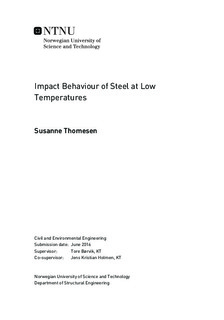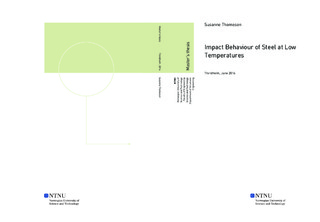| dc.description.abstract | The main objective of this thesis was to determine the impact behaviour of the high strength steel Strenx-960-Plus at room and low temperatures, and to investigate if the deformation and failure mode changed from ductile to brittle during ballistic perforation as the temperature was reduced. Both experimental and numerical investigations were carried out.
A substantial amount of material tests were conducted to characterize the material. Quasi-static tensile tests using three different specimen geometries were carried out at both room temperature (RT) and -40 oC, where a small effect of temperature was seen. The effect of strain rate was investigated through intermediate and high strain rate tests, using a hydro-pneumatic test machine and a Split-Hopkinson tension bar, respectively. The experimental results from the intermediate strain rate tests were irregular and therefore not used in the further work. In an attempt to determine the ductile-to-brittle transition temperature (DBTT) Charpy V-notch impact test were carried out at chosen temperatures in the interval from RT to -90 oC. A significant decrease in absorbed energy was observed, but no distinct transition temperature was found. The ballistic properties of the material were tested at selected temperatures in the range from RT to -60 oC. Target plates of the material were placed in a newly built temperature chamber, and fired at using 7.62 mm APM2 bullets. Ballistic limit velocity curves were obtained, showing only a minor effect of temperature. The deformation modes seen experimentally appeared to dependent only on the initial velocity, and not the temperature.
Based on the experimental results from the material tests at RT the model constants of the modified Johnson-Cook (MJC) material model, the Cockcroft-Latham (CL) fracture criterion and the Johnson-Cook (JC) fracture criterion were calibrated. Abaqus/Explicit was used in the numerical work, combined with the SIMLab Metal Model for the material input. Numerical models of the quasi-static tension tests and the high strain rate tests were used for verification and validation of the calibrated material model and fracture criteria. Numerical analyses of the Charpy V-notch test at RT proved to be highly dependent on the fracture criterion, but gave appropriate results in general. The ballistic impact test was modelled using 2D axisymmetry. The numerical results obtained provided a conservative estimate of the ballistic limit velocity at RT, deviating approximately 8\% from the experimental value. The numerical model predicted failure by ductile hole growth independent of initial velocity, which deviated visually from the experimental tests with initial velocities above approximately 800 m/s.
Lastly, a metallurgical study was performed. The grain structure of the material was examined in an optical microscope, and fracture surfaces of different specimens were examined using a scanning electron microscope. Specimens from tests at both RT and -40 oC were examined. Dimples, indicating ductile fracture, was dominating for all specimens, independent of geometry and temperature.
It was in general seen little effect of temperature on the ballistic properties for this material. For most practical applications the material can be regarded as ductile for the temperatures applied in this thesis. | en |

